[one_half]The pain inflicted by the COVID-19 pandemic has been particularly severe in Italy, a nation of 61 million people. On March 27 the Italian death toll surpassed 8,200—the world’s highest and more than twice the registered toll in China, a country of 1.4 billion.
Those bleak health figures translate into enormous challenges for the nation’s Catholic priests, as well as for the parishioners who turn to them for consolation.
Some 78 percent of adults in Italy identify as Catholic, according to Pew Research, and the linked histories of Italians and the Catholic Church reach back two millennia, to the very birth of Christianity and its establishment in Rome.
The legacy of that relationship is a matchless treasure trove of monuments, paintings, and sculptures. An annotated map of Italy is not simply a record of its lengthy (and sometimes uneasy) ties to the Church, it is also a chronicle of Western civilization.
Yet the record is also landmarked by calamities—wars, famines, and plagues. Since March 10, when Italy was ordered into a rigorous lock-down in a desperate effort to slow the COVID-19 contagion, its parishes have struggled to maintain their pastoral commitments while observing rules that could save countless lives.
“Normal human contact was almost completely closed,” says Father Enrico Schibuola, a priest in the agricultural town of Rovigo, 30 miles south of Padova. “We had to turn elsewhere, to telephones, computers, and social networks to keep in touch with people and address their needs.”
Rovigo-born photographer Chiara Negrello has been documenting the impact of the pandemic on her own family and neighbors. Her mother, who owns a small shop, has closed her business indefinitely. Her father works in a supermarket, an enterprise regarded as essential and allowed to remain open
Cautionary efforts appear to have paid off. Rovigo and its surrounding province have so far confirmed fewer than 100 coronavirus cases in a population of 250,000. The Province of Cremona, 120 miles to the west, has identified more than 3,000 cases among 360,000 residents.[/one_half]
[one_half_last]Special parish services, including meetings with troubled children and panic-stricken families, are now conducted via telephone or video. Streaming plans have been set in motion for the Lenten season, Easter Sunday (April 12), and the feast of the Virgin Mary (May 1). “Virtual Masses” are broadcast weekly on Facebook, YouTube, and the Diocesan radio station.
Social distancing is difficult everywhere, but it’s especially hard for Italians. A life without the public exchange of warm embraces and multiple kisses was unimaginable here—until it became a matter of life and death.
The shock is most evident in the trimming back of events that engender strong emotions. Baptisms and marriages are conducted in churches closed to all except parents and legal witnesses. As for deaths, “We’re advised, even when someone is clearly in their final days of life, that we shouldn’t visit them at home or at the hospital,” Father Enrico says.
There are staff priests at most hospitals, he added, and exceptional permits can be secured for home visits. But requests from parish families for such permits are in steep decline, notes photographer Negrello, “probably due to fear of the virus.”
BY FRANK VIVIANO – PHOTOGRAPHS BY CHIARA NEGRELLO – original article and many images can be seen here; https://www.nationalgeographic.com/history/2020/03/housebound-italians-embrace-virtual-mass-keep-faith-coronavirus/
All articles by Frank Viviano can be seen here
[/one_half_last]





